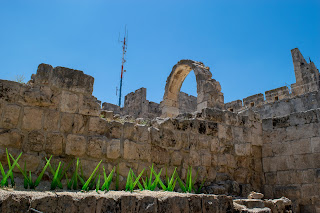Caves, caves, and more caves!
When I think of Bet Guvrin, that's first what comes to mind. But there's so much more to this park. It's HUGE and will be a 4-part series probably.
But today, CAVES!
There are so many caves carved in this area because of the rocks in the region are soft and chalk-like. It's this beautiful, creamy color and easy to quarry. So in this park are MANY caves that served as dove-cotes, quarries, cisterns, storerooms, tombs, and storage chambers. One of the caves was basically a maze, which I couldn't document clearly because you can't see the change of directions in a still photo. But it was A-MAZE-ING!!!
My favorites, though, were the Bell Caves. These bell-shaped caves were formed by quarrying in the Byzantine and Early Muslim periods. Their shape and the different colors of the earth, in addition to the light coming from the top, make them an incredible sight. Today, they are tourist attractions and also places for events like weddings and concerts. Can you imagine?!?
Also, I definitely heard bats in here. No, gracias!
But that's not the only kind of cave in Bet Guvrin. Here is the Polish cave. It originally a cistern that also doubled as a dovecote. It was given this name because of an inscription on a stone inside. During WWII, Polish soldiers visited the cave and carved an eagle, 1943, and Warsaw, Poland on the rock:
Then, there's the Columbarium. This cross-shaped cave was also a dove-cote that held more than 2,000 birds! Being so close to Jerusalem, these were likely raised for sacrifices, as well as being used for food and their droppings for fertilizer. There are over 85 dove-cote caves found in the area of Maresha alone with 10s of thousands of niches!
This photo is an example of the soft, chalk-like rock the caves are carved from:
Then, a cave with an ancient oil press:














































